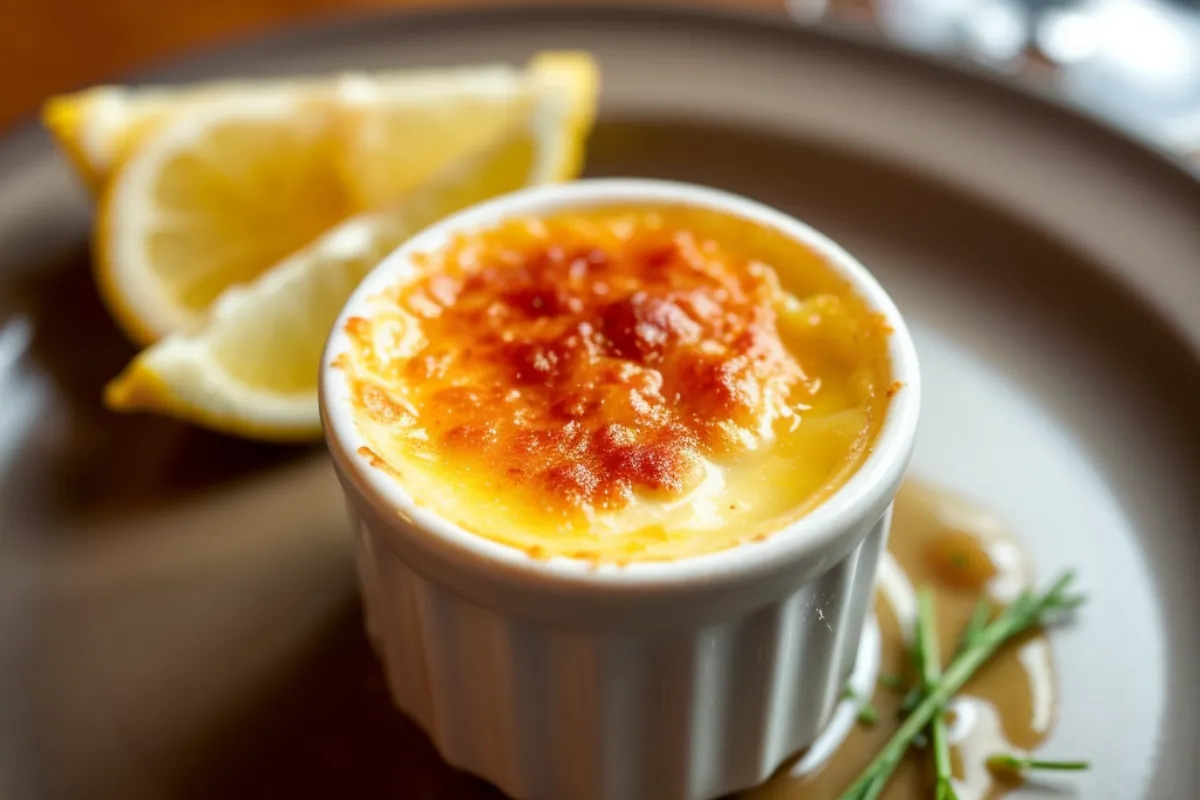Crab Brulee is a deliciously unique, savoury dish that takes inspiration from the classic crème brûlée. Imagine the creamy texture of traditional crème brûlée paired with the delicate, sweet flavour of fresh crab meat. This delightful fusion of flavours makes Crab Brulee a standout dish, perfect for impressing your guests at any gathering.
Introduction to Crab Brulee Recipe
Crab Brulee is a savory alternative to the sweet, custard-based dessert we all know and love. While crème brûlée is typically infused with vanilla and finished with a layer of caramelized sugar, Crab Brulee combines the rich creaminess of the custard with the subtle, sweet flavour of crab meat. The result is a sophisticated dish that can be served as an appetizer or a unique main course.
The Origins of Crème Brûlée
The history of crème brûlée dates back to France in the 17th century when it became a beloved dessert known for its contrasting textures: the creamy custard and the crunchy caramelized sugar topping. Over time, chefs around the world have experimented with this classic recipe, adding their unique twists, which led to the creation of savory variations like Crab Brulee. This innovation reflects the culinary trend of blending sweet and spicy elements to create complex, unforgettable dishes.
Essential Ingredients for Crab Brulee Recipe
To create the perfect Crab Brulee, you’ll need a few key ingredients that come together to produce a harmonious blend of flavours. Here’s what you’ll need:
- Fresh Crab Meat: The star of the dish, crab meat adds a subtle sweetness and rich flavour. Fresh crab is preferred for the best taste, but canned or frozen crab can be used if fresh is unavailable.
- Heavy Cream: This ingredient is crucial for achieving the rich, creamy texture of the custard. It adds body and depth to the dish.
- Egg Yolks: Egg yolks are the binding agent that holds the custard together, ensuring a smooth, velvety texture.
- Lemon Zest: The zest adds a touch of acidity, balancing the richness of the cream and enhancing the crab’s natural flavour.
- Spices and Herbs: Seasoning is critical. A pinch of Old Bay seasoning or cayenne pepper can add a subtle kick, while fresh herbs like tarragon, dill, or chives introduce a delightful herbal note.
Optional Ingredients for Extra Flavor
- Parmesan Cheese: For those who enjoy a hint of cheese, adding grated Parmesan can elevate the flavour profile of your Crab Brulee.
- Herb Variations: Try experimenting with different herbs, such as cilantro or parsley, to create a unique twist on the traditional recipe.
Step-by-Step Preparation
Creating Crab Brulee may sound daunting, but the process is relatively straightforward. Follow these steps for a dish that is sure to impress.
Preparing the Crab Meat
Start by selecting the freshest crab meat you can find. If you’re using live crabs, you’ll need to cook and clean them first. For convenience, pre-cooked crab meat from the seafood counter or canned crab meat can be used.
Making the Custard Base
- Heat the Cream: Pour the heavy cream into a saucepan and heat it over medium heat until it begins to simmer. Avoid boiling the cream, as this can alter the texture.
- Whisk the Egg Yolks: In another bowl, Whisk the egg yolks until they lighten in colour and slightly thicken.
- Combine Cream and Yolks: Gradually pour the hot cream into the egg yolks, whisking continuously to prevent the eggs from curdling.
- Season the Mixture: Add a pinch of salt, black or white pepper, and freshly grated nutmeg to the mixture. Stir in the lemon zest and any additional herbs or spices you choose.
Assembling the Dish
- Prepare the Ramekins: Place your chosen crab meat at the bottom of each ramekin. If using fresh herbs, sprinkle them over the crab meat.
- Pour the Custard: Carefully pour the custard mixture over the crab meat, filling the ramekins nearly to the top.
- Water Bath: Place the ramekins in a baking dish and fill the dish with hot water until it reaches about halfway up the sides of the ramekins. This water bath helps the custard cook evenly and prevents it from curdling.
Baking the Crab Brulee
- Bake: Preheat your oven to 320°F (160°C). Bake the custards for 35-40 minutes or until they are just set and still slightly jiggly in the centre.
- Cool: Remove the ramekins from the oven and let them cool to room temperature. Once cooled, refrigerate the custards for at least 3-4 hours, or overnight, to allow them to set fully.
Caramelizing the Sugar Topping
Just before serving, Sprinkle a thin layer of granulated sugar on top of each custard. Use a culinary torch to caramelize the sugar until it forms a crisp, golden crust. The contrast between the creamy custard and the crunchy sugar is one of the highlights of this dish.
Variations and Customizations
Crab Brulee is a versatile dish that can be customized to suit your taste preferences. Here are some variations to consider:
Spicy Crab Brulee
- Add Cayenne Pepper: For a spicy kick, add a pinch of cayenne pepper to the custard mixture. This adds warmth and complexity to the dish.
Herbal Crab Brulee
- Use Fresh Herbs: Incorporate fresh herbs such as tarragon, dill, or chives into the custard or sprinkle them on top before baking. This adds a refreshing herbal note that pairs beautifully with the crab.
Cheesy Crab Brulee Recipe
- Parmesan Twist: Mix in grated Parmesan cheese with the custard mixture for a richer, more decadent flavour. The cheese adds a savoury depth that complements the sweetness of the crab.
Serving Suggestions
- Top with Fresh Herbs: Right before serving, add a sprinkle of fresh herbs to your. Crab Brulee with a sprig of fresh herbs for a touch of colour and added flavour.
- Pair with Wine: For a sophisticated pairing, serve Crab Brulee with crisp white wine.
Pro Tips for Making the Best Crab Brulee Recipe
Creating the perfect Crab Brulee requires attention to detail. Here are some expert tips to ensure your dish turns out flawlessly every time:
- Use Fresh Crab Meat: Fresh crab meat provides the best flavour and texture. If you must use canned or frozen crab, be sure to drain and pat it dry to remove excess moisture.
- Avoid Overcooking: The key to a perfect custard is careful baking. Overcooked custard can become grainy, so keep an eye on the baking time and remove the custards from the oven while they are still slightly jiggly in the centre.
- Cool Before Serving: Allow the custards to cool entirely before caramelizing the sugar. This helps prevent the custard from burning when you use the torch.
- Caramelize Just Before Serving: For the best texture, caramelize the sugar topping just before serving. This ensures the crust remains crisp and doesn’t become soggy.
Troubleshooting Common Issues
Even with the best intentions, things can go wrong in the kitchen. Here’s how to handle some common issues when making Crab Brulee:
- Runny Custard: If your custard is too runny, it may have been undercooked. Try extending the baking time by a few minutes, or ensure your oven is at the correct temperature.
- Overcooked Custard: Overcooked custard can become grainy. To avoid this, remove the custards from the oven as soon as they are set but still slightly jiggly.
- Curdled Mixture: If your custard mixture curdles, it may be due to adding the hot cream too quickly. Always add the cream gradually while whisking to avoid curdling.
- Adjusting Flavors: If the flavour isn’t quite right, consider changing the seasoning. A touch more salt, a bit of lemon zest, or additional herbs can make all the difference.
Nutritional Breakdown
Understanding the nutritional content of your dishes is essential, especially when you’re indulging in decadent recipes like Crab Brulee. Here’s a breakdown of the nutritional information:
- Calories: Approximately 536 kcal per serving
- Carbohydrates: 10g
- Protein: 15g
- Fat: 49g
- Saturated Fat: 30g
- Cholesterol: 395mg
- Sodium: 685mg
- Fiber: 0.04g
- Sugar: 10g
This dish is indulgent, so it’s best enjoyed as a special treat. The combination of cream and crab provides a good source of protein and fat, but be mindful of portion sizes to keep your meal balanced.
Storage and Reheating Instructions
Crab Brulee can be stored in the refrigerator for up to 2-3 days. Use these tips to keep your leftovers fresh:
- Storage: Cover the ramekins tightly with plastic wrap and store them in the refrigerator.
- Reheating: To reheat, place the custards in a preheated oven at a low temperature (around 300°F or 150
Frequently Asked Questions
Q: What is Crab Brulee Recipe?
A: Crab Brulee Recipe is a savoury twist on the classic crème brûlée, combining the creamy texture of custard with the delicate, sweet flavour of fresh crab meat. It’s typically served as an appetizer or unique main course, offering a blend of rich flavours and textures.
Q: What are the essential ingredients for making Crab Brulee?
A: The key ingredients include fresh crab meat, heavy cream, egg yolks, lemon zest, and spices such as salt, pepper, and optionally Old Bay seasoning or cayenne pepper. Fresh herbs like tarragon or dill and Parmesan cheese can also be added for extra flavour. To know more about this recipes check this article.
Q: How do you prepare the custard base for Crab Brulee?
A: To prepare the custard, you need to heat the cream until it simmers, then gradually whisk it into the egg yolks. After seasoning the mixture, it is then poured over the crab meat in ramekins. Next, the ramekins are baked in a water bath, which ensures even cooking and a smooth texture.
Q: What are some variations of the Crab Brulee recipe?
A: Variations include Spicy Crab Brulee, which adds cayenne pepper for heat; Herbal Crab Brulee, which incorporates fresh herbs like dill or tarragon; and Cheesy Crab Brulee, where Parmesan cheese is mixed into the custard for added richness.
Q: How do you caramelize the sugar topping on Crab Brulee?
A: Once the custards have cooled, you should then sprinkle a thin layer of granulated sugar over the top. Afterward, use a kitchen torch to melt and caramelize the sugar until it forms a crisp, golden crust. If you don’t have a torch, you can use a broiler for a similar effect.
Q: What should I do if my custard turns out too runny?
A: If your custard is too runny, it likely needs more time in the oven. Make sure to bake it until the custard is set but still slightly jiggly in the center. Check the oven temperature and adjust the baking time as needed.
Q: Can I use canned crab meat instead of fresh crab meat?
A: Yes, you can use canned crab meat if fresh crab is unavailable. However, fresh crab meat is preferred for the best flavor and texture. If you’re using canned crab, make sure to drain it and pat it dry to eliminate any excess moisture.
Q: How should I store leftover Crab Brulee?
A: Leftover Crab Brulee can be stored in the refrigerator for up to 2-3 days. Cover the ramekins tightly with plastic wrap to maintain freshness. When reheating, use a low oven temperature to warm the custards gently.
Q: What makes Crab Brulee different from traditional crème brûlée?
A: The primary difference is the savoury twist: Crab Brulee incorporates crab meat into the custard, while traditional crème brûlée is a sweet dessert flavoured with vanilla and topped with caramelized sugar. Crab Brulee combines the richness of seafood with the creamy texture of the custard, creating a unique dish.
Q: What wines pair well with Crab Brulee?
A: Crab Brulee pairs wonderfully with crisp white wines like Sauvignon Blanc or Pinot Grigio, as these wines balance the dish’s richness and offer a refreshing contrast.

